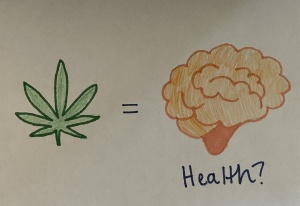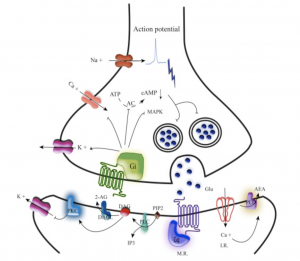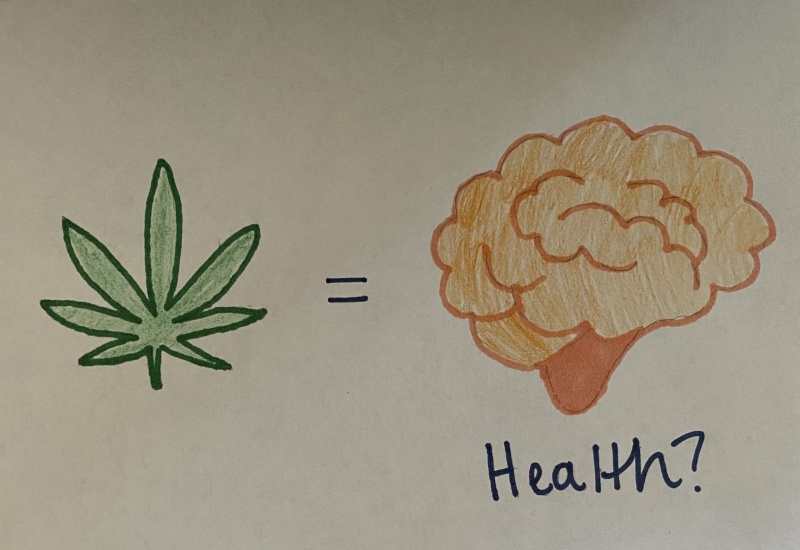Background:
Endocannabinoids are gaining media exposure as many states are legalizing the recreational and medicinal use of marijuana, which contains the numerous endocannabinoids, the two most commonly mentioned are CBD and THC. Endocannabinoids are signaling molecules that are naturally made throughout the body, including the brain, that act as signaling molecules for various processes: stress, cognition, immunity, pain, eating, anxiety, reproduction, growth, and metabolism. Endocannabinoids are synthesized from fatty acids in the phospholipid bilayer of the post-synaptic neuron when calcium concentrations rise due to too much excitatory signaling. The two main endocannabinoids synthesized in the brain are AEA (N-arachidonoylethanolamide) and 2-AG (2-arachidonoylglycerol). Once the endocannabinoids are synthesized, the molecules are then released and can bind to CB1 and CB2 (G-protein coupled receptors) receptors to set off various signaling cascades.
Endocannabinoid Receptors:
AEA and 2-AG readily bind to CB1 receptors, which are highly concentrated in the brain and even throughout the rest of the body. Most often, these ligands inhibit the release of neurotransmitters in the presynaptic cell to tell the neuron to stop releasing neurotransmitters as a retrograde signaling cascade. The neurotransmitters that AEA and 2-AG typically inhibit dopamine and glutamate from being released from the pre-synaptic neuron to stop excitatory signaling.
AEA and 2-AG can also bind to CB2 receptors, which are found in cells that have immune functions. CB2 receptors are often found on microglia, which are responsible for producing inflammatory and anti-inflammatory cytokines in the brain. One interesting finding is that CB2 receptors have been found to be downregulated or malfunctioning in some neurodegenerative diseases including Multiple Sclerosis and Alzheimer’s Disease.

Signaling Pathway:
The CB1 and CB2 receptor activation via THC has shown great promise in activating the MAPK/PI3K, which ultimately activates BDNF or brain-derived neurotrophic factor, as seen in Figure 2. BDNF is responsible for promoting life-sustaining roles that include neurogenesis, synaptic plasticity, and neuroprotection. Neurogenesis slows down with aging and can also account for a more difficult time learning, as well as reduced synaptic plasticity due to decreased activation of BDNF. However, it is interesting to think about THC improving the synthesis of BDNFs to improve cognition and memory, as well as have neuroprotective factors. Thus, THC is currently being studied as a potential treatment for neurodegenerative diseases and traumatic brain injuries.

THC is also an antioxidant, which could help to reduce amyloid beta plaques and hyperphosphorylation of tau. On the other hand, consuming a diet high in fruits and vegetables could also provide antioxidant properties as consuming THC to help manage age-related diseases and produce neuroprotective factors.
Side effects:
Consuming cannabis is not without side-effects. Some studies have demonstrated that marijuana can be addictive, approximately 9% of all people who use the substance will lead to a dependence. However, those who use cannabis in their teens can see a heightened dependence rate of 17%. Teenagers who use cannabis can also experience a decline in IQ and increased mental health issues.
Another alarming side effect of cannabis use is the interaction with other drugs, especially anesthetics. Users of cannabis require four times the amount of Propofol during surgery than those who do not use cannabis. Propofol can interact with both CB1 and CB2 receptors to reduce the release of dopamine, norepinephrine, and epinephrine and increase GABA release. THC has the exact opposite effects of Propofol. Increased amounts of anesthetics can increase the risk for adverse side effects. More research needs to be done to understand the negative impacts of THC exposure and anesthetic interactions.
So what?
More research needs to be done on cannabis and the endocannabinoids that it contains. Cannabis is a Schedule I Drug, so it is incredibly difficult and expensive to study. New research is hard to attain due to this classification, yet legalization of recreational and medicinal use is becoming more and more common in the United States. Thus, cannabis use for studies should also become more readily available to educate users and work to better understand how cannabis can be used to treat neurodegenerative illnesses.
Sources:
- https://www.frontiersin.org/articles/10.3389/fncel.2016.00294/full
- https://www.sciencedirect.com/science/article/pii/B9780128002131000158
- https://www.frontiersin.org/articles/10.3389/fncel.2019.00363/full
- https://www.researchgate.net/publication/322146675_Functional_Foods_in_the_Management_of_Neurodegenerative_Diseases
- https://www.drugabuse.gov/publications/research-reports/marijuana/marijuana-addictive
- https://www.anesthesiologynews.com/Clinical-Anesthesiology/Article/10-19/Regular-Marijuana-Use-Changes-Anesthesia-Needs/56086?sub=36F3CFDB6E5DCB6B427D1D3E23351E11EAEBB4459197186048A5C7FE69&enl=true&dgid=X3676465&utm_source=enl&utm_content=4&utm_campaign=20191031&utm_medium=title
- https://www.aana.com/docs/default-source/aana-journal-web-documents-1/marijuana-use-in-the-anesthetized-patient-history-pharmacology-and-anesthetic-considerations-december-2019.pdf?sfvrsn=ce829198_4
